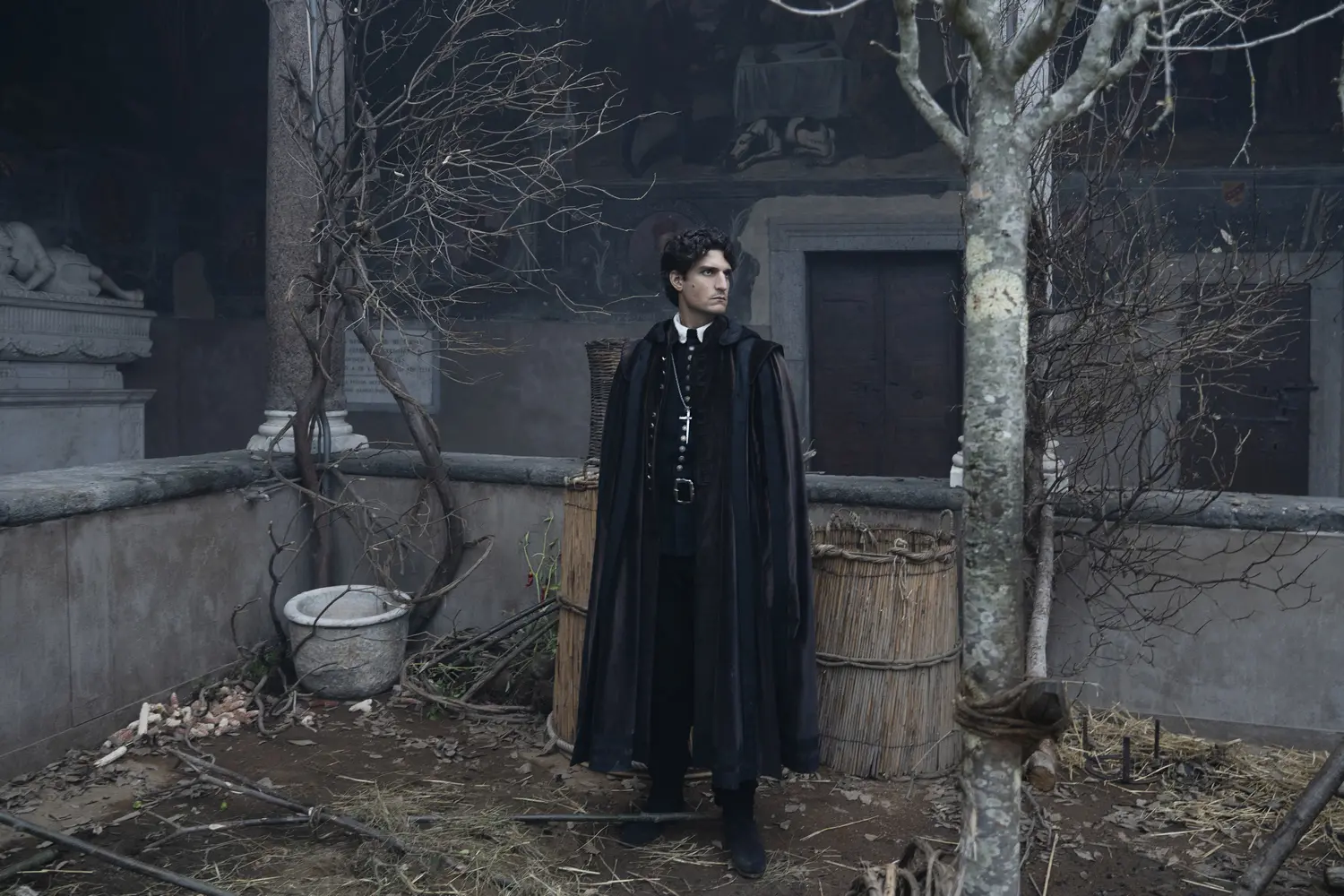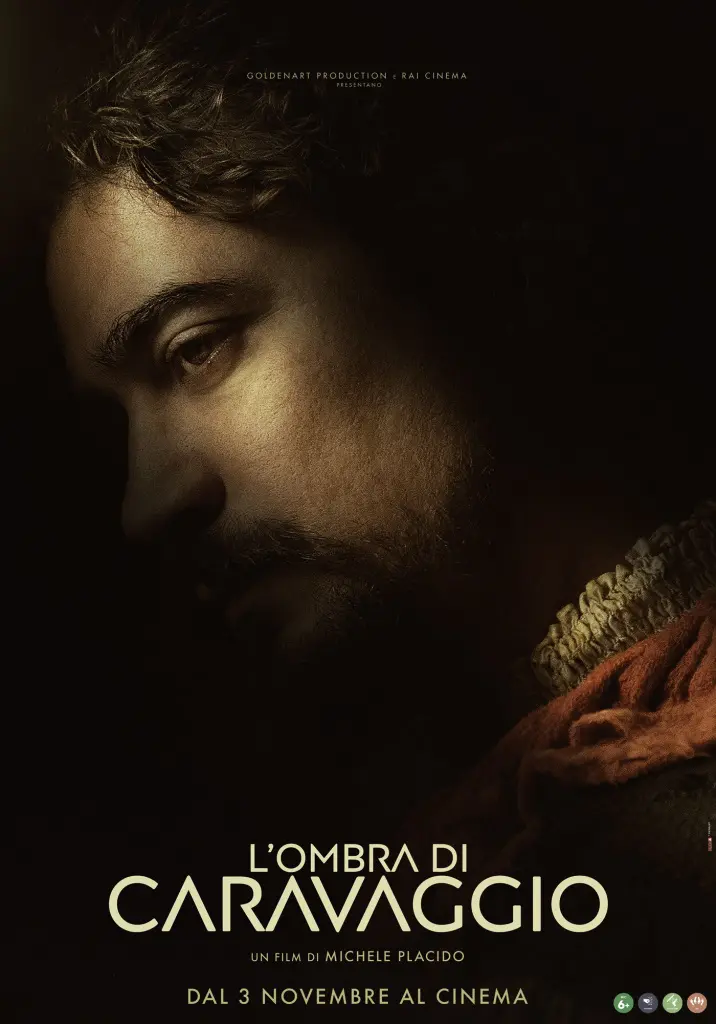
We use cookies
We use cookies and other tracking technologies to improve your browsing experience on our website, to show you personalized content and targeted ads, to analyze our website traffic, and to understand where our visitors are coming from.

Caravaggio’s Shadow has two main locations: Rome where Caravaggio lives (more or less) from 1592 to 1606 when Michelangelo Merisi (played by Riccardo Scamarcio) kills Ranuccio Tomassoni and Naples where he flees to escape the death sentence.

In addition to Rome, the region of Lazio provided other locations including several areas in the Tuscia area, in particular: Sutri, Nepi and the Ruspoli Castle in Vignanello. The earliest part of the film is set in the Papal States; multiple flashbacks set up the artist’s obsession in finding “truth” in the eyes, expressions and intense poses of the faces and bodies of prostitutes, thieves and vagabonds. His brush “steals” men and women from Rome’s Suburra or Filippo Neri’s Church of Santa Maria in Vallicella, redeeming them from a life of insignificance and anonymity by transforming them into saints and virgins to whom the great and good of the Church are required to kneel. This unrelenting search leads the unruly Michelangelo to spend most of his time in taverns and with women of the street: the area beneath the Baths of Caracalla provided the dark, filthy city streets, with open sewers, brimming with the so-called “unfortunates”; the artist’s studio and the taverns, churches, fortresses and streets of Rome were built in the soundstages of Cinecittà.
Caravaggio’s charm and fame, however, filter into the noble palaces of power to affect high ranking figures like Costanza Colonna (Isabelle Huppert) or Cardinal Francesco Maria Del Monte (Michele Placido): the Colonna residence was created from several rooms in Villa Chigi; the studio of Cavalier d’Arpino, Caravaggio’s teacher and rival, was set up in Palazzo Chigi di Ariccia which also provided corners used for Palazzo Colonna and Cardinal Del Monte’s residence, while some of the painter’s disputed works were filmed at Villa Aldobrandini di Frascati. Ariccia also contributed piazza di Corte and via dell’Uccelliera as locations.
The painter lived in Naples from 1606 to 1607, spending time in the “quartieri Spagnoli”, and again from 1609-1610, before he left heading to his death. The city was used for scenes reproducing 17th century Naples and for the painter’s chaotic Roman life. The argument with the painter Giovanni Baglione (Vinicio Marchioni) takes place near the monumental complex of Santa Maria La Nova as does the parting kiss between Caravaggio and his assistant at the end of the film (in this case the portal at the top of the imposing staircase where the two men approach belongs to the Basilica of St. Dominic Major). The cloister of Santa Maria La Nova serves as La Vallicella where Filippo Neri protects and feeds the unfortunate including Lena Antonietti (Micaela Ramazzotti), a prostitute who becomes the artist’s model and lover.
Sets were also created in the underground areas of Naples, mostly in the galleria Borbonica: this was used for the Roman prison where Caravaggio has an intense conversation with Giordano Bruno (Gianfranco Gallo), several hours before he is burnt to death in Campo de’ Fiori. Other corners of the galleria provide the archives where Ombra(Louis Garrel) does his research (the interiors of Teatro Instabile in vico Fico Purgatorio ad Arco, in the historic centre, were also used) and where he meets and slaps Ranuccio’s brother.
The burial area beneath the Church of Santa Maria delle Anime del Purgatorio ad Arco was used in the scene where a wounded Caravaggio meets Anna who appears as an angel: her damaged body would be recorded in The Death of the Virgin, one of the artist’s most vibrant and controversial works.
The complex of the Charterhouse and Museum of San Martino provides the background for scenes featuring Paul V (Maurizio Donadoni), e.g., when the Pope entrusts Ombra with the omission to investigate Caravaggio and when the artist is questioned by the Inquisition.
Renaissance and Baroque complexes in Naples were used to recreate the Contarelli Chapel, the Cerasi Chapel and the Church of Sant’Agostino (the Curia of Rome would not allow filming inside these Roman churches): these included the Church of Saints Severino and Sossio and museum complex of Donna Regina.
The film documents the artist’s time in Malta, between his two Naples residencies, where the artist lived under the protection of the Knights of the Cross of Malta. Several Malta scenes were created in underground areas beneath Castel dell’Ovo (Naples).
Caravaggio’s Shadow has two main locations: Rome where Caravaggio lives (more or less) from 1592 to 1606 when Michelangelo Merisi (played by Riccardo Scamarcio) kills Ranuccio Tomassoni and Naples where he flees to escape the death sentence.

In addition to Rome, the region of Lazio provided other locations including several areas in the Tuscia area, in particular: Sutri, Nepi and the Ruspoli Castle in Vignanello. The earliest part of the film is set in the Papal States; multiple flashbacks set up the artist’s obsession in finding “truth” in the eyes, expressions and intense poses of the faces and bodies of prostitutes, thieves and vagabonds. His brush “steals” men and women from Rome’s Suburra or Filippo Neri’s Church of Santa Maria in Vallicella, redeeming them from a life of insignificance and anonymity by transforming them into saints and virgins to whom the great and good of the Church are required to kneel. This unrelenting search leads the unruly Michelangelo to spend most of his time in taverns and with women of the street: the area beneath the Baths of Caracalla provided the dark, filthy city streets, with open sewers, brimming with the so-called “unfortunates”; the artist’s studio and the taverns, churches, fortresses and streets of Rome were built in the soundstages of Cinecittà.
Caravaggio’s charm and fame, however, filter into the noble palaces of power to affect high ranking figures like Costanza Colonna (Isabelle Huppert) or Cardinal Francesco Maria Del Monte (Michele Placido): the Colonna residence was created from several rooms in Villa Chigi; the studio of Cavalier d’Arpino, Caravaggio’s teacher and rival, was set up in Palazzo Chigi di Ariccia which also provided corners used for Palazzo Colonna and Cardinal Del Monte’s residence, while some of the painter’s disputed works were filmed at Villa Aldobrandini di Frascati. Ariccia also contributed piazza di Corte and via dell’Uccelliera as locations.
The painter lived in Naples from 1606 to 1607, spending time in the “quartieri Spagnoli”, and again from 1609-1610, before he left heading to his death. The city was used for scenes reproducing 17th century Naples and for the painter’s chaotic Roman life. The argument with the painter Giovanni Baglione (Vinicio Marchioni) takes place near the monumental complex of Santa Maria La Nova as does the parting kiss between Caravaggio and his assistant at the end of the film (in this case the portal at the top of the imposing staircase where the two men approach belongs to the Basilica of St. Dominic Major). The cloister of Santa Maria La Nova serves as La Vallicella where Filippo Neri protects and feeds the unfortunate including Lena Antonietti (Micaela Ramazzotti), a prostitute who becomes the artist’s model and lover.
Sets were also created in the underground areas of Naples, mostly in the galleria Borbonica: this was used for the Roman prison where Caravaggio has an intense conversation with Giordano Bruno (Gianfranco Gallo), several hours before he is burnt to death in Campo de’ Fiori. Other corners of the galleria provide the archives where Ombra(Louis Garrel) does his research (the interiors of Teatro Instabile in vico Fico Purgatorio ad Arco, in the historic centre, were also used) and where he meets and slaps Ranuccio’s brother.
The burial area beneath the Church of Santa Maria delle Anime del Purgatorio ad Arco was used in the scene where a wounded Caravaggio meets Anna who appears as an angel: her damaged body would be recorded in The Death of the Virgin, one of the artist’s most vibrant and controversial works.
The complex of the Charterhouse and Museum of San Martino provides the background for scenes featuring Paul V (Maurizio Donadoni), e.g., when the Pope entrusts Ombra with the omission to investigate Caravaggio and when the artist is questioned by the Inquisition.
Renaissance and Baroque complexes in Naples were used to recreate the Contarelli Chapel, the Cerasi Chapel and the Church of Sant’Agostino (the Curia of Rome would not allow filming inside these Roman churches): these included the Church of Saints Severino and Sossio and museum complex of Donna Regina.
The film documents the artist’s time in Malta, between his two Naples residencies, where the artist lived under the protection of the Knights of the Cross of Malta. Several Malta scenes were created in underground areas beneath Castel dell’Ovo (Naples).

Goldenart, Charlot, Le Pacte, Rai Cinema, Mact Productions
Italy 1610. Caravaggio is both one of the most brilliant painters of his time and a rebel against Church rulings that dictate how religious subjects are represented. Having been informed that Caravaggio depicts prostitutes, thieves and vagabonds in his work, Pope Paul V orders the Vatican secret service to investigate, to decide whether to grant the clemency for which the painter has petitioned since being sentenced to death for the murder of a rival in love. The investigator – known as The Shadow - begins the inquiry that will lead him to discover the conflicting vices and virtues of the genius whose life – or death – lies in his hands.